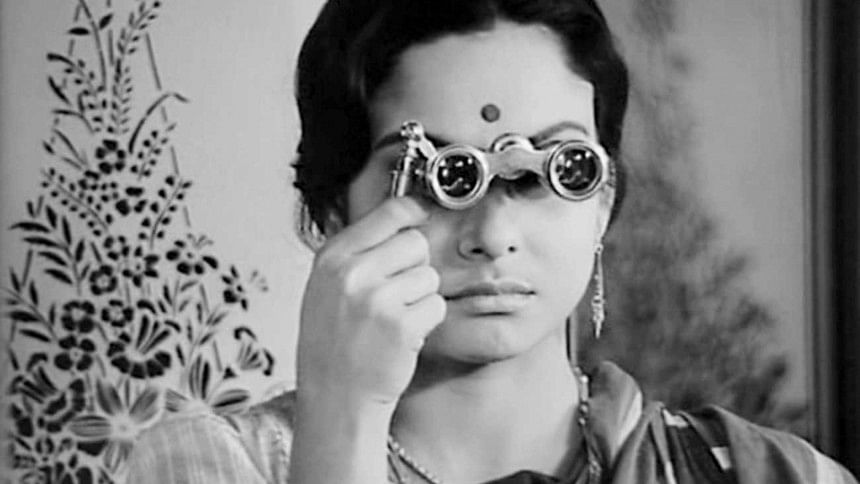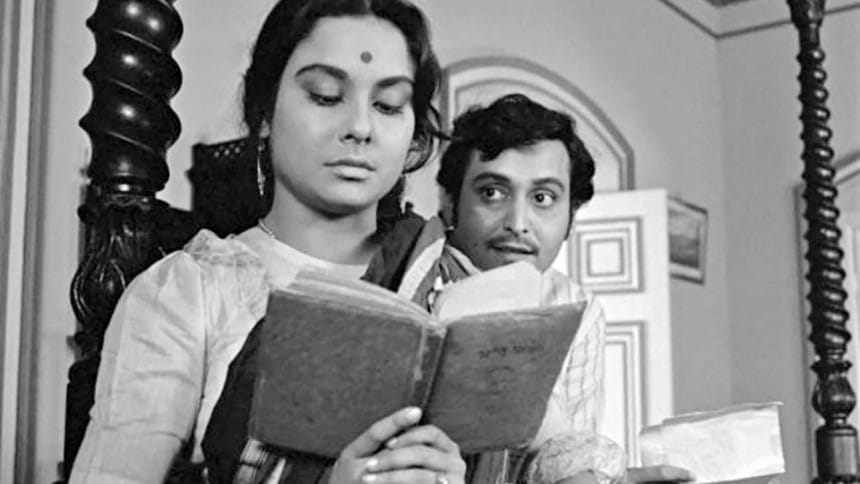Charulata - The Art of Adaptation

In 1901, after coming back to Shantiniketan from the tiring experience of running a zamindari in Shilaidaha, Rabindranath Tagore wrote the short story Nashtanirh (The Broken Nest), a love triangle set in 19th century Bengal. The story, when published, did not receive as much attention as other works of Tagore and was later included in Golpo Guccha, Tagore's compilation of short stories. Sixty-three years later, however, Nashtanirh finally garnered the acclaim it deserved, thanks to a visionary filmmaker. In 1964, as a tribute to Tagore, Satyajit Ray adapted this short story into celluloid and named it Charulata. This cinema is considered by critics as Ray's best work. To celebrate Ray's art of adaptation we take a closer look into this wonderful work of cinema.
Charulata can be described as a meditative composition which portrays the inner conflict endured by its characters entangled in a love triangle explored in a masterfully nuanced manner—with a certain melancholic grace. The film starts off with Bhupati, a well-meaning modern man whose only interest is in running a newspaper, The Sentinel. His work keeps him away from his young and comely wife, Charu, the protagonist of the film. To give her company, Bhupati invites his cousin, Amal, whose infectious energy and literary bent of mind matches that of Charulata's. A deep bond develops between them over a short period of time. Meanwhile, at The Sentinel, Bhupati is betrayed by his own brother-in-law, Umapada, who manages the newspaper's finances. Seeing Bhupati suffer at Umapada's hands, Amal comes to the conclusion that his blossoming romance with Charulata must not come to Bhupati's notice as it might shatter the man. Amal leaves, Bhupati realises Charulata is pining for Amal, but all three maintain a dignified, melancholic silence.
Charulata is considered to be the best remodelling of literature to narrative cinema and is taught in most film schools under screenplay analysis and adaptation. Though it was based on Nashtanirh, Ray, who wrote the screenplay in addition to directing the film, refashioned a lot of the elements from Tagore's original text. As we know, a screenplay and a short story are two completely different forms and require very different treatments. The visuals of a film have their own language, which means that Ray had to improvise to tell the narrative in his own way. For example, Tagore's Amal was a demanding man. He is seen tormenting Charu to the point of seeming insensitive to her feelings and situation. Tagore's Amal seems almost needy. Ray, on the other hand, adds an endearing tenderness to the character Amal.
Charulata's and Amal's literary pursuits are another aspect of the story that Ray translated to cinema in a way that added both subtlety and sorrow. In Nashtanirh, it is literature that brings Charulata and Amal together, but Ray uses their shared love of writing to create a fortress of solitude for the two of them—one that kept the real world away, one in which they were equals unburdened by convention and hierarchy.

At the end of the film, Ray makes an obvious departure from the novella. In the book, after Amal leaves, Charulata asks Bhupati if she can accompany him on a trip that he's about to go on and when he hesitates, she says, “Let it be.” Ray recreated those tentative steps that the couple takes towards each other as well as the melancholia with a wordless scene: Charulata simply holds out her hand and Bhupati hesitates to take it. The freeze frame shows a page of Bhupati's newspaper lying in the background; the newspaper that was once Charulata's rival for Bhupati's attention now acts as an instrument in bringing her close to Amal. Incidentally, this ending was actually not in the original script. Ray had initially envisioned that Bhupati would take Charulata's hand and the camera would see them walk to their bedroom, hand in hand. While shooting, however, Ray changed his mind and came up with the idea of a more open-ended scene.
Ray's work with the camera added another layer to the narrative, proving, once again, that cinematic details can sometimes tell more than the dialogue itself. Let's take the first few shots of the film, for example. Throughout the first sequence, Ray's camera unobtrusively follows Charu as she roams restlessly around the house, framing and reframing her in a series of spaces—doorways, corridors, pillared galleries—emphasising both the Victorian-Bengali luxury of her surroundings and her confinement within them. Though subjective shots are largely reserved for Charu's glimpses of street life, the tracking shots that mirror her progress along the gallery, or move in from behind her shoulder as she glides from window to window, give us the sense of her comfortable but tamed life. The only deviation from this pattern takes place after she retrieves the opera glasses. A fast lateral track keeps the glasses in close-up as she holds them by her side and hurries back to the windows, the camera sharing her devil-may-care avidity. We also see Charu in front of the bookshelf looking for Bankim Chandra's Kopal Kundala, while humming the name Bankim herself . This mid shot not only gives us a glimpse of Charu's character and intellect but also, as pointed out by Ray, pays tribute to a key figure of Bangla literature.
Music, too, plays a huge role in expressing the characters' emotions mostly through renditions of Tagore's own work. We hear the tune of “Momo Chitte”, played over the opening images, and Amal sings “Phule Phule” which Charu later hums in the garden as they grow ever closer emotionally. Ray puts modern instrumental variations on the musical score. The blend of western classical music with Tagore's soulful melodies truly adds another layer of emotion to the narrative.
Like most of Ray's work, Charulata portrays a miraculous clarity combined with outstanding acting and theatrical composure and shot with natural genius. Considered to have the effortless fluency and delight of a Shakespearean comedy, Charulata works as a tonic for the eyes and soul, and is the kind of celluloid narrative that serves as the quintessential example of perfect transition from one medium to another.

 For all latest news, follow The Daily Star's Google News channel.
For all latest news, follow The Daily Star's Google News channel. 



Comments